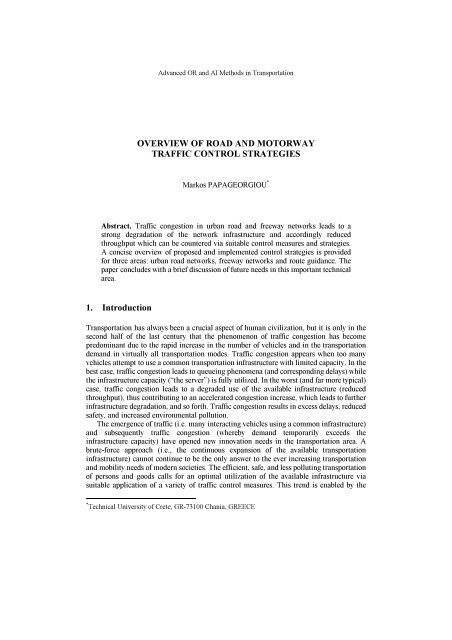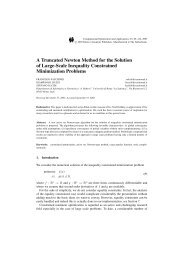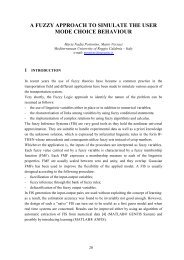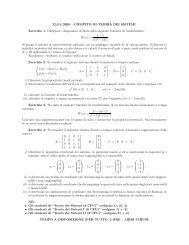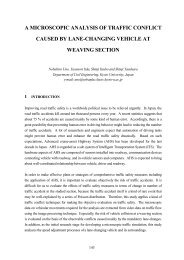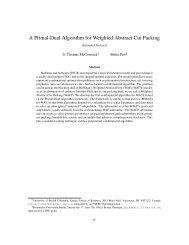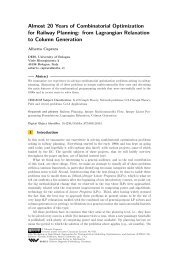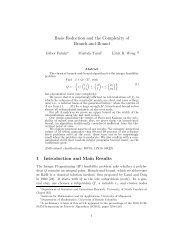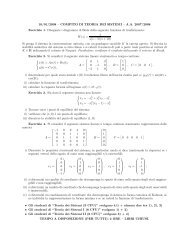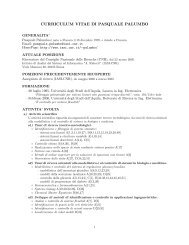OVERVIEW OF ROAD AND MOTORWAY TRAFFIC ... - Iasi.cnr.it
OVERVIEW OF ROAD AND MOTORWAY TRAFFIC ... - Iasi.cnr.it
OVERVIEW OF ROAD AND MOTORWAY TRAFFIC ... - Iasi.cnr.it
You also want an ePaper? Increase the reach of your titles
YUMPU automatically turns print PDFs into web optimized ePapers that Google loves.
Advanced OR and AI Methods in Transportation<br />
<strong>OVERVIEW</strong> <strong>OF</strong> <strong>ROAD</strong> <strong>AND</strong> <strong>MOTORWAY</strong><br />
<strong>TRAFFIC</strong> CONTROL STRATEGIES<br />
Markos PAPAGEORGIOU *<br />
Abstract. Traffic congestion in urban road and freeway networks leads to a<br />
strong degradation of the network infrastructure and accordingly reduced<br />
throughput which can be countered via su<strong>it</strong>able control measures and strategies.<br />
A concise overview of proposed and implemented control strategies is provided<br />
for three areas: urban road networks, freeway networks and route guidance. The<br />
paper concludes w<strong>it</strong>h a brief discussion of future needs in this important technical<br />
area.<br />
1. Introduction<br />
Transportation has always been a crucial aspect of human civilization, but <strong>it</strong> is only in the<br />
second half of the last century that the phenomenon of traffic congestion has become<br />
predominant due to the rapid increase in the number of vehicles and in the transportation<br />
demand in virtually all transportation modes. Traffic congestion appears when too many<br />
vehicles attempt to use a common transportation infrastructure w<strong>it</strong>h lim<strong>it</strong>ed capac<strong>it</strong>y. In the<br />
best case, traffic congestion leads to queueing phenomena (and corresponding delays) while<br />
the infrastructure capac<strong>it</strong>y (“the server”) is fully utilized. In the worst (and far more typical)<br />
case, traffic congestion leads to a degraded use of the available infrastructure (reduced<br />
throughput), thus contributing to an accelerated congestion increase, which leads to further<br />
infrastructure degradation, and so forth. Traffic congestion results in excess delays, reduced<br />
safety, and increased environmental pollution.<br />
The emergence of traffic (i.e. many interacting vehicles using a common infrastructure)<br />
and subsequently traffic congestion (whereby demand temporarily exceeds the<br />
infrastructure capac<strong>it</strong>y) have opened new innovation needs in the transportation area. A<br />
brute-force approach (i.e., the continuous expansion of the available transportation<br />
infrastructure) cannot continue to be the only answer to the ever increasing transportation<br />
and mobil<strong>it</strong>y needs of modern societies. The efficient, safe, and less polluting transportation<br />
of persons and goods calls for an optimal utilization of the available infrastructure via<br />
su<strong>it</strong>able application of a variety of traffic control measures. This trend is enabled by the<br />
* Technical Univers<strong>it</strong>y of Crete, GR-73100 Chania, GREECE
Overview of road and motorway traffic control strategies 35<br />
rapid developments in the areas of communications and computing (telematics), but <strong>it</strong> is<br />
qu<strong>it</strong>e evident that the efficiency of traffic control directly depends on the efficiency and<br />
relevance of the employed control methodologies.<br />
disturbances<br />
demand<br />
incidents<br />
control<br />
inputs<br />
Control<br />
Devices<br />
Control<br />
Strategy<br />
Traffic<br />
Network<br />
Sensors<br />
Surveillance<br />
total time spent<br />
measurements<br />
REAL WORLD<br />
COMPUTER<br />
goals<br />
Human-Machine<br />
Interface<br />
Fig. 1. The control loop.<br />
Figure 1 illustrates the basic elements of a control loop. The traffic flow behaviour in<br />
the (road or freeway or mixed) traffic network depends on some external quant<strong>it</strong>ies that are<br />
classified into two groups: Control inputs that are directly related to corresponding control<br />
devices (actuators), such as traffic lights, variable message signs, etc.; Disturbances, whose<br />
values cannot be manipulated, but may possibly be measurable (e.g. demand) or detectable<br />
(e.g. incident) or predictable over a future time horizon. The network’s output or<br />
performance is measured via su<strong>it</strong>able indices, such as the total time spent by all vehicles in<br />
the network over a time horizon. The task of the Surveillance is to enhance and to extend<br />
the information provided by su<strong>it</strong>able sensors (e.g. inductive loop detectors) as required by<br />
the subsequent control strategy and the human operators. The kernel of the control loop is<br />
the Control Strategy, whose task is to specify in real time the control inputs, based on<br />
available measurements/estimations/predictions, so as to achieve the pre-specified goals<br />
(e.g. minimization of total time spent) desp<strong>it</strong>e the influence of various disturbances. The<br />
relevance and efficiency of the control strategy largely determines the efficiency of the<br />
overall control system. Therefore control strategies should be designed w<strong>it</strong>h care, via<br />
application of powerful and systematic methods of optimization and automatic control,<br />
rather than via questionable heuristics [1].
36 M. Papageorgiou<br />
2. Road Traffic Control<br />
2.1. Basic Notions<br />
Traffic lights at intersections is the major control measure in urban road networks. An<br />
intersection (or junction) consists of a number of approaches and the crossing area. An<br />
approach may have one or more lanes but has a unique, independent queue. Approaches<br />
are used by corresponding traffic streams (veh/h). Two compatible streams can safely cross<br />
the intersection simultaneously, else they are called antagonistic. A signal cycle is one<br />
repet<strong>it</strong>ion of the basic series of signal combinations at an intersection; <strong>it</strong>s duration is called<br />
cycle time. A stage (or phase) is a part of the signal cycle, during which one set of streams<br />
has r.o.w. (Fig. 2). Constant lost (or intergreen) times of a few seconds are necessary<br />
between stages to avoid interference between antagonistic streams of consecutive stages<br />
(Fig. 3).<br />
stage 1 stage 2<br />
stage 3<br />
cycle<br />
Fig. 2. Example of signal cycle.<br />
stage 1<br />
stage 2<br />
stage 3<br />
cycle time<br />
lost time<br />
Fig. 3. Cycle time and lost times.<br />
There are four possibil<strong>it</strong>ies for influencing traffic cond<strong>it</strong>ions via traffic lights operation:<br />
• Stage specification: For complex intersections, the specification of the optimal<br />
number and const<strong>it</strong>ution of stages is a non-trivial task that can have a major impact<br />
on intersection capac<strong>it</strong>y and efficiency.<br />
• Spl<strong>it</strong>: This is the relative green duration of each stage (as a portion of the cycle<br />
time) that should be optimized according to the demand of the involved streams.
Overview of road and motorway traffic control strategies 37<br />
• Cycle time: Longer cycle times typically increase the intersection capac<strong>it</strong>y because<br />
the proportion of the constant lost times becomes accordingly smaller; on the other<br />
hand, longer cycle times may increase vehicle delays in undersaturated intersections<br />
due to longer wa<strong>it</strong>ing times during the red phase.<br />
• Offset: This is the time difference between cycles for successive intersections that<br />
may give rise to a “green wave” along an arterial; clearly.<br />
Control strategies employed for road traffic control may be classified according to the<br />
following characteristics:<br />
• Fixed-time strategies for a given time-of-day (e.g. morning peak hour) are derived<br />
off-line by use of appropriate optimization codes based on historical constant<br />
demands and turning rates for each stream; traffic-responsive strategies make use<br />
of real-time measurements (typically one or two inductive loops per link) to<br />
calculate in real time the su<strong>it</strong>able signal settings.<br />
• Isolated strategies are applicable to single intersections while coordinated<br />
strategies consider an urban zone or even a whole network comprising many<br />
intersections.<br />
• Most available strategies are only applicable to undersaturated traffic cond<strong>it</strong>ions,<br />
whereby vehicle queues are only created during the red phases and are dissolved<br />
during the green phases; very few strategies are su<strong>it</strong>able also for oversaturated<br />
cond<strong>it</strong>ions w<strong>it</strong>h partially increasing queues that in many cases reach the upstream<br />
intersections.<br />
2.2. Isolated Intersection Control<br />
Fixed-time strategies. Isolated fixed-time strategies are only applicable to undersaturated<br />
traffic cond<strong>it</strong>ions. Stage-based strategies under this class determine the optimal spl<strong>it</strong>s and<br />
cycle time so as to minimize the total delay or maximize the intersection capac<strong>it</strong>y. Phasebased<br />
strategies determine not only optimal spl<strong>it</strong>s and cycle time but also the optimal<br />
staging, which may be an important feature for complex intersections. Wellknown<br />
examples of stage-based strategies are SIGSET [2] and SIGCAP [3] Phase-based<br />
approaches [4] solve a similar problem, su<strong>it</strong>ably extended to consider different staging<br />
combinations.<br />
Traffic-responsive strategies. Isolated, traffic-responsive strategies make use of realtime<br />
measurements provided by inductive loop detectors that are usually located some 40 m<br />
upstream of the stop line, to execute some more or less sophisticated vehicle-actuation<br />
logic. One of the simplest strategies under this class is the vehicle-interval method that is<br />
applicable to two-stage intersections. A more sophisticated version of this kind of strategies<br />
was proposed by Miller [5] and is included in the control tool MOVA [6].<br />
2.3. Fixed-Time Coordinated Control<br />
The most popular representatives of this class of strategies for urban networks are outlined<br />
below. By their nature, fixed-time strategies are only applicable to undersaturated traffic<br />
cond<strong>it</strong>ions.
38 M. Papageorgiou<br />
MAXB<strong>AND</strong> [7] considers a two-way arterial including several subsequent signals<br />
(intersections) and specifies the corresponding offsets so as to maximize the number of<br />
vehicles that can travel w<strong>it</strong>hin a given speed range w<strong>it</strong>hout stopping at any signal<br />
(green wave). A number of significant extensions have been introduced in the original<br />
method in order to consider a variety of new aspects such as different bandwidths for each<br />
link of the arterial (MULTIB<strong>AND</strong>) [8].<br />
TRANSYT [9] is the most known and most frequently applied signal control strategy,<br />
and <strong>it</strong> is often used as a reference method to test improvements enabled by real-time<br />
strategies. Figure 4 depicts the method’s basic structure whereby the procedure is an<br />
<strong>it</strong>erative one: For given values of the decision variables (control inputs), i.e. of spl<strong>it</strong>s,<br />
offsets, and cycle time, the dynamic network model calculates the corresponding<br />
performance index, e.g. the total number of vehicle stops. A heuristic “hill-climb”<br />
optimization algor<strong>it</strong>hm introduces small changes to the decision variables and orders a new<br />
model run, and so forth, until a (local) minimum is found.<br />
The main drawback of fixed-time strategies is that their settings are based on historical<br />
rather than real-time data. This may be a crude simplification because:<br />
• Demands are not constant, even w<strong>it</strong>hin a time-of-day.<br />
• Demands may vary at different days, e.g. due to special events.<br />
• Demands change in the long term leading to “aging” of the optimized settings.<br />
• Turning movements are also changing in the same ways as demands; in add<strong>it</strong>ion,<br />
turning movements may change due to the drivers’ response to the new optimised<br />
signal settings, whereby they try to minimize their individual travel times.<br />
• Incidents and farther disturbances may perturb traffic cond<strong>it</strong>ions in a nonpredictable<br />
way.<br />
TRANSYT Program<br />
network data,<br />
flow data<br />
optimization<br />
data<br />
new signal<br />
settings<br />
in<strong>it</strong>ial<br />
signal<br />
settings<br />
traffic<br />
model<br />
optimization<br />
procedure<br />
optimum<br />
signal<br />
settings<br />
performance<br />
index<br />
delays and<br />
stops in<br />
network<br />
graphs of<br />
cyclic flow<br />
profiles<br />
Fig. 4. Structure of TRANSYT (after [9]).
Overview of road and motorway traffic control strategies 39<br />
For all these reasons, traffic-responsive coordinated strategies, if su<strong>it</strong>ably designed, are<br />
potentially more efficient, but also more costly, as they require the installation, operation,<br />
and maintenance of a real-time control system (sensors, communications, central control<br />
room, local controllers).<br />
2.4. Coordinated Traffic-Responsive Strategies<br />
SCOOT [10] has been applied to over 150 c<strong>it</strong>ies in the Un<strong>it</strong>ed Kingdom and elsewhere.<br />
SCOOT utilizes traffic volume and occupancy measurements from the upstream end of the<br />
network links. It runs in a central control computer and employs a philosophy similar to<br />
TRANSYT.<br />
Model-based optimisation methods. More recently, a number of more rigorous modelbased<br />
traffic-responsive strategies have been developed: OPAC [11], PRODYN [12],<br />
CRONOS [13], RHODES [14]. These strategies do not consider explic<strong>it</strong>ly spl<strong>it</strong>s, offsets, or<br />
cycles. Based on pre-specified staging, they calculate in real time the optimal values of the<br />
next few sw<strong>it</strong>ching times τ i,<br />
i = 1, 2, …, over a future time horizon H, starting from the<br />
current time t and the currently applied stage. The rolling horizon procedure is employed<br />
for real-time application.<br />
Store-and-forward based modelling has been used in various road traffic control<br />
approaches because <strong>it</strong> opens the way to the application of a number of highly efficient<br />
optimization methods (such as linear, quadratic and nonlinear programming). Alternatively<br />
a multivariable regulator approach can be employed such as in the signal control strategy<br />
TUC [15] to calculate in real time the network spl<strong>it</strong>s, while cycle time and offsets are<br />
calculated by other parallel algor<strong>it</strong>hms. TUC was recently implemented and compared in<br />
Southampton, Munich and Chania w<strong>it</strong>h the respective resident strategies SCOOT,<br />
BALANCE and TASS [16].<br />
2.5. Integrated Urban-Freeway Traffic Control<br />
Modern metropol<strong>it</strong>an traffic networks include both urban roads and freeways and employ a<br />
variety of control measures such as signal control, ramp metering, variable message signs<br />
and route guidance. Trad<strong>it</strong>ionally, control strategies for each type of control measure are<br />
designed and implemented separately, which may result in antagonistic actions and lack of<br />
synergy among different control strategies and actions. However, modern traffic networks<br />
that include various infrastructure types, are perceived by the users as an ent<strong>it</strong>y, and all<br />
included control measures, regardless of their type or location, ultimately serve the same<br />
goal of higher network efficiency. Integrated control strategies should consider all control<br />
measures simultaneously towards a common control objective. Desp<strong>it</strong>e some preliminary<br />
works on this subject the problem of control integration is qu<strong>it</strong>e difficult due to <strong>it</strong>s high<br />
dimensions that reflect the geographical extension of the traffic network.
40 M. Papageorgiou<br />
3. Freeway Traffic Control<br />
3.1. Motivation<br />
Freeways had been originally conceived so as to provide virtually unlim<strong>it</strong>ed mobil<strong>it</strong>y to<br />
road users, w<strong>it</strong>hout the annoyance of flow interruptions by traffic lights. The rapid increase<br />
of traffic demand, however, led soon to increasingly severe congestions, both recurrent<br />
(occurring daily during rush hours) and non-recurrent (due to incidents). The increasingly<br />
congested freeways w<strong>it</strong>hin and around metropol<strong>it</strong>an areas resemble the urban traffic<br />
networks before introduction of traffic lights: Chaotic cond<strong>it</strong>ions at intersections, long<br />
queues, degraded infrastructure utilization, reduced safety. At the present stage, responsible<br />
author<strong>it</strong>ies have not fully realized that the expensive freeway-network infrastructure is<br />
strongly underutilized on a daily basis due to the lack of efficient and comprehensive traffic<br />
control systems. In other words, the expensive infrastructure is intended to deliver a<br />
nominal capac<strong>it</strong>y that is not available (due to congestion), ironically, exactly at the time <strong>it</strong> is<br />
most urgently needed (during peak hours). The control measures that are typically<br />
employed in freeway networks are:<br />
• Ramp metering, activated via installation of traffic lights at on-ramps or freeway<br />
interchanges.<br />
• Link control, that comprises a number of possibil<strong>it</strong>ies including lane control,<br />
variable speed lim<strong>it</strong>s, congestion warning, tidal (reversable) flow, keep-lane<br />
instructions, etc.<br />
• Driver information and guidance systems, e<strong>it</strong>her by use of roadside variable<br />
message signs or via two-way communication w<strong>it</strong>h equipped vehicles.<br />
Ramp metering is the most direct way to control and upgrade freeway traffic. Various<br />
pos<strong>it</strong>ive effects are achievable if ramp metering is appropriately applied:<br />
• Increase in mainline throughput due to avoidance or reduction of congestion.<br />
• Increase in the served volume due to avoidance of blocked off-ramps or freeway<br />
interchanges.<br />
• Utilization of possible reserve capac<strong>it</strong>y on parallel arterials.<br />
• Efficient incident response.<br />
• Improved traffic safety due to reduced congestion and safer merging.<br />
Some recent studies have demonstrated that efficient ramp metering strategies may<br />
provide spectacular improvements in large-scale freeway networks [17].<br />
3.2. Fixed-Time Ramp Metering Strategies<br />
Fixed-time ramp metering strategies are derived off-line for particular times-of-day, based<br />
on constant historical demands and simple static models w<strong>it</strong>hout use of real-time<br />
measurements. This approach was first suggested by Wattleworth [18] and leads to linear<br />
programming or quadratic programming problems.<br />
The drawbacks of fixed-time ramp metering strategies are identical to the ones<br />
discussed under road traffic control. In add<strong>it</strong>ion, fixed-time ramp metering strategies may
Overview of road and motorway traffic control strategies 41<br />
lead (due to the absence of real-time measurements) e<strong>it</strong>her to overload of the mainstream<br />
flow (congestion) or to underutilization of the freeway. In fact, ramp metering is an<br />
efficient but also delicate control measure. If ramp metering strategies are not accurate<br />
enough, then congestion may not be prevented from forming, or the mainstream capac<strong>it</strong>y<br />
may be underutilized (e.g. due to groundlessly strong metering).<br />
3.3. Reactive Ramp Metering Strategies<br />
Reactive ramp metering strategies are employed at a tactical level, i.e. in the aim of keeping<br />
the freeway traffic cond<strong>it</strong>ions close to pre-specified set values, based on real-time<br />
measurements.<br />
Local ramp metering. Local ramp metering strategies make use of traffic<br />
measurements in the vicin<strong>it</strong>y of a ramp to calculate su<strong>it</strong>able ramp metering values. The<br />
demand-capac<strong>it</strong>y and occupancy strategies [19] are based on an open-loop disturbancerejection<br />
policy and are qu<strong>it</strong>e popular in North America. An alternative, closed-loop ramp<br />
metering strategy (ALINEA), suggested in [20] is based on classical feedback concepts and<br />
is qu<strong>it</strong>e popular in Europe. Comparative field trials have been conducted in various<br />
countries to assess and compare the efficiency of local ramp metering strategies, see e.g.<br />
[21], whereby ALINEA outperformed feedforward-based strategies w<strong>it</strong>h respect to all<br />
evaluation cr<strong>it</strong>eria.<br />
Multivariable regulator strategies. Multivariable regulators for ramp metering pursue<br />
the same goals as local ramp metering strategies but they make use of all available<br />
mainstream measurements on a freeway stretch to calculate simultaneously the ramp<br />
volume values for all controllable ramps included in the same stretch [22]. The<br />
multivariable regulator strategy METALINE may be viewed as a generalisation and<br />
extension of ALINEA. Field trials and simulation results comparing the efficiency of<br />
METALINE versus ALINEA lead to the following conclusions:<br />
• While ALINEA requires hardly any design effort, METALINE application calls for<br />
a rather sophisticated design procedure that is based on advanced control-theoretic<br />
methods (LQR optimal control).<br />
• For urban freeways w<strong>it</strong>h a high dens<strong>it</strong>y of on-ramps, METALINE was found to<br />
provide no advantages over ALINEA (the latter implemented independently at each<br />
controllable on-ramp) under recurrent congestion.<br />
• In the case of non-recurrent congestion (e.g. due to an incident), METALINE<br />
performs better than ALINEA due to more comprehensive measurement<br />
information.<br />
Corridor impact. Some system operators hes<strong>it</strong>ate to apply ramp metering because of<br />
the concern that congestion may be conveyed from the freeway to the adjacent street<br />
network. In fact, a ramp metering application designed to avoid or reduce congestion on<br />
freeways may have both pos<strong>it</strong>ive and negative effects on the adjacent road network traffic.<br />
However, if an efficient control strategy is applied for ramp metering, the freeway<br />
throughput will be generally increased. More precisely, ramp metering at the beginning of<br />
the rush hour may lead to on-ramp queues in order to prevent congestion to form on the<br />
freeway, which may temporarily lead to diversion towards the urban network. But due to<br />
congestion avoidance or reduction, the freeway will be eventually enabled to accommodate<br />
a higher throughput, thus attracting drivers from urban paths and leading to an improved
42 M. Papageorgiou<br />
overall network performance. This pos<strong>it</strong>ive impact of ramp metering on both the freeway<br />
and the adjacent road network traffic cond<strong>it</strong>ions was confirmed in a specially designed field<br />
evaluation in the Corridor Périphérique in Paris [23].<br />
3.4. Nonlinear Optimal Ramp Metering Strategies<br />
Reactive ramp metering strategies are very helpful, but, first they need appropriate set<br />
values, and, second, the scope of their actions is more or less local. What is needed for<br />
freeway networks or long freeway stretches is a superior coordination level that calculates<br />
in real time optimal set values from a proactive, strategic point of view. Such an optimal<br />
control strategy should explic<strong>it</strong>ly take into account:<br />
• The current traffic state both on the freeway and on the on-ramps.<br />
• Demand predictions over a sufficiently long time horizon.<br />
• The lim<strong>it</strong>ed storage capac<strong>it</strong>y of the on-ramps.<br />
• The ramp metering constraints discussed earlier.<br />
• The nonlinear traffic flow dynamics, including the infrastructure’s lim<strong>it</strong>ed<br />
capac<strong>it</strong>y.<br />
• Any incidents currently present in the freeway network.<br />
Such a comprehensive dynamic optimal control problem may be formulated and solved<br />
w<strong>it</strong>h moderate computation time by use of su<strong>it</strong>able numerical algor<strong>it</strong>hms. This problem or<br />
variations thereof was considered and solved in various works, see [24] for an overview<br />
Although simulation studies indicate substantial savings of travel time and substantial<br />
increase of throughput, advanced control strategies of this kind have not been implemented<br />
in the field as of yet.<br />
Figure 5 displays an example of (simulated) optimal control application using the<br />
generic software tool AMOC for the Amsterdam ringroad A10 (counter-clockwise direction<br />
only) over a typical morning-peak period of 4 hours [17]. When no ramp metering is<br />
applied, the excessive demand coupled w<strong>it</strong>h the uncontrolled entrance of drivers into the<br />
mainstream, causes a time-space extended congestion (Fig. 5b) that blocks almost half of<br />
the freeway off-ramps, thus leading to a strongly reduced throughput. W<strong>it</strong>h application of<br />
optimal ramp metering, congestion is avoided (Fig. 5c), throughput is maximized, and the<br />
total time spent by all vehicles (including wa<strong>it</strong>ing time at the ramps) is reduced by 43.5%<br />
compared to no control.<br />
3.5. Link Control<br />
Link control may include one or a combination of the following actions:<br />
• Variable speed lim<strong>it</strong>ation<br />
• Changeable message signs w<strong>it</strong>h indications for “keep lane”, or congestion warning,<br />
or environmental warning (e.g. information about the pavement state)<br />
• Lane control measures (e.g. prohib<strong>it</strong>ed lane use upstream of heavily used on-ramps<br />
or incident locations)<br />
• Incident or congestion warning<br />
• Reversable flow lanes (tidal flow).
Overview of road and motorway traffic control strategies 43<br />
(a)<br />
(b)<br />
(c)<br />
Fig. 5. Optimal ramp metering for the Amsterdam ringroad (counter-clockwise<br />
direction): (a) Network sketch, (b) Dens<strong>it</strong>y profile w<strong>it</strong>hout and<br />
(c) w<strong>it</strong>h optimal ramp metering control.<br />
There are many freeway stretches, particularly in Germany, in The Netherlands, and,<br />
more recently, in the Un<strong>it</strong>ed Kingdom, employing a selection of these measures. It is<br />
generally thought that control measures of this kind lead to a homogenization of traffic flow<br />
(i.e. more homogeneous speeds of cars w<strong>it</strong>hin a lane and of average speeds on different<br />
lanes) which is believed to reduce the risk of falling into congestion at high traffic dens<strong>it</strong>ies<br />
and to increase the freeway’s capac<strong>it</strong>y.
44 M. Papageorgiou<br />
4. Route Guidance and Driver Information<br />
4.1. Introduction<br />
Freeway, urban, or mixed traffic networks include a large number of origins and<br />
destinations w<strong>it</strong>h multiple paths connecting each origin-destination pair. Fixed direction<br />
signs at bifurcation nodes of the network typically indicate the direction that is timeshortest<br />
in absence of congestion. However, during rush hours, the travel time on many<br />
routes changes substantially due to traffic congestion and alternative routes may become<br />
compet<strong>it</strong>ive. Drivers who are familiar w<strong>it</strong>h the traffic cond<strong>it</strong>ions in a network (e.g.<br />
commuters) optimize their individual routes based on their past experience, thus leading to<br />
the celebrated user-equilibrium cond<strong>it</strong>ions, first formulated by Wardrop [25]. But daily<br />
varying demands, changing environmental cond<strong>it</strong>ions, exceptional events (sport events,<br />
fairs, concerts, etc.) and, most importantly, incidents may change the traffic cond<strong>it</strong>ions in a<br />
non-predictable way. This may lead to an underutilization of the overall network’s capac<strong>it</strong>y,<br />
whereby some links are heavily congested while capac<strong>it</strong>y reserves are available on<br />
alternative routes. Route guidance and driver information systems (RGDIS) may be<br />
employed to improve the network efficiency via direct or indirect recommendation of<br />
alternative routes.<br />
A first classification of RGDIS distinguishes pre-trip from en-route advice. Pre-trip<br />
communication possibil<strong>it</strong>ies include the internet, phone services, mobile devices, television<br />
and radio. These communication devices may be consulted by a potential road user to make<br />
a rational decision regarding:<br />
• The effectuation or postponement of the intended trip<br />
• The choice of transport mode (car, bus, underground, etc.)<br />
• The choice of the departure time<br />
• The (in<strong>it</strong>ial) path choice.<br />
If the road user has decided to complete the trip by car, they may continue to receive<br />
information or advice via appropriate en-route devices such as radio services (RDS-TMC),<br />
road-side variable message sings (VMS), or special in-car equipment, in order to make<br />
sensible routing decisions at bifurcation nodes of the network. While radio broadcasting<br />
services and VMS have been in use for more than 25 years (and their number is steadily<br />
increasing) individual route guidance systems employing in-car devices and two-way<br />
communication w<strong>it</strong>h control centers are in their infancy.<br />
At this point, <strong>it</strong> is appropriate to distinguish among two alternative policies (which in<br />
some cases may be combined) of providing en-route information versus explic<strong>it</strong> route<br />
recommendation. Many operators (particularly of VMS-based systems) prefer the provision<br />
of real-time information. Also the major<strong>it</strong>y of drivers (according to some questionnaire<br />
results) seem to prefer this option that enables them to make their own decisions, rather<br />
than having to follow recommendations by an anonymous system. It should be emphasized,<br />
however, that pure information provision has a number of partially significant drawbacks:<br />
• The translation of provided information into routing decisions requires the<br />
knowledge of the network which may not be present for all drivers.
Overview of road and motorway traffic control strategies 45<br />
• Although the control centre disposes over complete information about the traffic<br />
cond<strong>it</strong>ions in the whole network, only a tiny part of this information can be<br />
conveyed to the users due to space lim<strong>it</strong>ations on the VMS and other devices, which<br />
may not be sufficient for a rational route decision.<br />
• Even if <strong>it</strong> would be possible to provide more comprehensive information, the<br />
drivers would have to make a route decision w<strong>it</strong>hin a few seconds, i.e. after looking<br />
at the VMS and before reaching the bifurcation.<br />
• There is no possibil<strong>it</strong>y for the operator or a control strategy to actively influence<br />
traffic cond<strong>it</strong>ions, as decisions are left w<strong>it</strong>h the drivers.<br />
On the other hand, route guidance systems are constrained by the requirement not to<br />
suggest routes that would disbenef<strong>it</strong> complying drivers, else the credibil<strong>it</strong>y and eventually<br />
the impact of the whole system may be jeopardized. Moreover, route guidance systems call<br />
for a genuine control strategy in the sense of Fig. 1.<br />
4.2. Travel Time Display<br />
A particular type of driver information system that is gaining increasing momentum due to<br />
<strong>it</strong>s relative simplic<strong>it</strong>y and <strong>it</strong>s popular<strong>it</strong>y w<strong>it</strong>h drivers is the display (on VMS) of travel times<br />
for well-defined stretches downstream of the VMS. This information is readily<br />
comprehensible by the drivers, and <strong>it</strong> may e<strong>it</strong>her provide a basis for route choice decisions<br />
or simply reduce the drivers’ stress, particularly in congested traffic cond<strong>it</strong>ions. For<br />
example, some 350 VMS are installed on the Boulevard Périphérique of Paris (France) and<br />
on all approaches that lead to this ringway [26]. A similar system, providing travel times on<br />
the two downstream freeway links of each bifurcation node, is operational in the dense<br />
freeway network around Paris, see Fig. 6 for an example.<br />
Clearly, any instantaneous travel time formula based only on current traffic<br />
measurements will induce a systematic estimation error if the traffic cond<strong>it</strong>ions in the<br />
stretch are rapidly changing, e.g. during congestion growth or dissipation. A scheme that<br />
delivers predicted travel times that come closer to the travel times that will be experienced<br />
by the drivers during their trip may be based on:<br />
• Historical information<br />
• Su<strong>it</strong>able extrapolation methods (e.g. time series or neural networks)<br />
• Employment of dynamic traffic flow models in real time<br />
or a combination of the above.<br />
4.3. Route Guidance Strategies<br />
Basic Notions. A route guidance system may be viewed as a traffic control system in the<br />
sense of Fig. 1. Based on real-time measurements, sufficiently interpreted and extended<br />
w<strong>it</strong>hin the surveillance block, a control strategy decides about the routes to be<br />
recommended (or the information to be provided) to the road users. Because of the realtime<br />
nature of the operation, requirements of short computation times are relatively strict.<br />
Route guidance strategies may be classified according to various aspects:<br />
• Reactive strategies are based only on current measurements w<strong>it</strong>hout the real-time<br />
use of mathematical models or other predictive tools; predictive strategies attempt
46 M. Papageorgiou<br />
to predict traffic cond<strong>it</strong>ions sufficiently far in the future in order to improve the<br />
qual<strong>it</strong>y of the provided recommendations.<br />
Fig. 6. Example of a Variable Message Sign (VMS) display in the Ile-de-France<br />
freeway network around Paris (France); this VMS is located just upstream of a<br />
freeway bifurcation whose outgoing links A1 and A3 eventually lead to the<br />
Boulevard Périphérique (BP). The sign informs (first line) that the current travel<br />
time from the VMS on A1 until BP is 12 min w<strong>it</strong>h increasing tendency,<br />
while (second line) the travel time from the VMS on A3 until BP is 21 min<br />
w<strong>it</strong>h decreasing tendency.<br />
• Iterative strategies run several model simulations in real time, each time w<strong>it</strong>h<br />
su<strong>it</strong>ably modified route guidance, to ensure (at convergence) that the control goal<br />
will be achieved as accurately as possible; <strong>it</strong>erative strategies are by nature<br />
predictive. One-shot strategies may e<strong>it</strong>her be reactive, in which case they typically<br />
perform simple calculations based on real-time data, or they may be predictive,<br />
whereby they run one single time a simulation model to increase the relevance of<br />
their recommendations.<br />
• Route guidance strategies may aim at e<strong>it</strong>her system optimal or user optimal traffic<br />
cond<strong>it</strong>ions. In the first case, the control goal is the minimisation of a global<br />
objective cr<strong>it</strong>erion (e.g. the total time spent) even for the price of recommending<br />
routes that are sometimes more costly than the regular routes. In the second case,<br />
every recommended route should not be more costly than the regular route, even for<br />
the price of sub-optimal<strong>it</strong>y w<strong>it</strong>h respect to the global objective cr<strong>it</strong>erion.<br />
One-shot strategies. Particularly for dense networks, w<strong>it</strong>h relatively short links, many<br />
bifurcations, and a high number of alternative routes connecting any two nodes, reactive<br />
strategies may be highly efficient in establishing user-optimal cond<strong>it</strong>ions on the basis of<br />
current traffic measurements. Most reactive strategies are decentralized, i.e. they conduct<br />
their calculations at each bifurcation node independently of other nodes. Simple feedback<br />
regulators of the P (proportional) or PI (proportional-integral) types have been proposed in<br />
[27]. An operational system employing decentralized P-regulators in the traffic network of<br />
Aalborg, Denmark, was reported in [28].<br />
A different kind of one-shot strategies may employ in real time a mathematical model<br />
of the network traffic flow which is run once, in order to provide information about the<br />
future traffic cond<strong>it</strong>ions under the current route guidance settings. A regulator is then used<br />
to control the predicted future, rather than the current, traffic cond<strong>it</strong>ions. Such control<br />
schemes are preferable to reactive regulators when the traffic network has long links w<strong>it</strong>h a<br />
lim<strong>it</strong>ed number of bifurcation nodes. A control scheme of this kind was applied to the<br />
Scottish highway network employing P-regulators or a heuristic expert system [29].
Overview of road and motorway traffic control strategies 47<br />
Iterative strategies may aim at establishing e<strong>it</strong>her system-optimal or user-optimal<br />
cond<strong>it</strong>ions. For a system optimum the corresponding optimal control problem may be<br />
solved by use of the same numerical algor<strong>it</strong>hms as the optimal ramp metering problem. On<br />
the other hand, there are also several <strong>it</strong>erative procedures suggested towards establishing<br />
user optimal cond<strong>it</strong>ions [30], [31], [32]. The typical core structure of these <strong>it</strong>erative<br />
strategies is as follows:<br />
• Set the in<strong>it</strong>ial path assignments or spl<strong>it</strong>ting rates (control inputs).<br />
• Run a simulation model over a time horizon H.<br />
• Evaluate the travel times on alternative utilized paths; if all travel time differences<br />
are sufficiently small, stop w<strong>it</strong>h the final solution.<br />
• Modify the path assignments or spl<strong>it</strong>ting rates appropriately to reduce travel time<br />
differences; go to (b).<br />
The simulation models employed by different algor<strong>it</strong>hms in step (b) may be<br />
microscopic, macroscopic, or mesoscopic. The real-time implementation of <strong>it</strong>erative<br />
algor<strong>it</strong>hms for route guidance purposes employs the rolling horizon procedure in order to<br />
reduce the sens<strong>it</strong>iv<strong>it</strong>y w<strong>it</strong>h respect to predicted demands and modeling inaccuracies.<br />
5. Future Directions<br />
As in many other engineering disciplines, only a small portion of the significant<br />
methodological advancements have really been explo<strong>it</strong>ed in the field as of yet.<br />
Administrative inertia; l<strong>it</strong>tle compet<strong>it</strong>ive pressure in the public sector; industrial interest in<br />
(expensive) hardware rather than in (low-cost) methodologies; the complex<strong>it</strong>y of traffic<br />
control systems; lim<strong>it</strong>ed realization of the improvement potential behind advanced methods<br />
by the responsible author<strong>it</strong>ies; and lim<strong>it</strong>ed understanding of practical problems by some<br />
researchers may have a role in this. Whatever the reasons, the major challenge in the<br />
coming decade is the deployment of advanced and efficient traffic control strategies in the<br />
field, w<strong>it</strong>h particular focus on addressing traffic saturation phenomena (congestion).<br />
More precisely, the major<strong>it</strong>y of small and big c<strong>it</strong>ies even in industrialized countries are<br />
still operating old-fashioned fixed-time signal control strategies, often even poorly<br />
optimized or maintained. Even when modern traffic-responsive control systems are<br />
installed in terms of hardware devices, the employed control strategies are often naïve,<br />
poorly tested and fine-tuned, thus failing to explo<strong>it</strong> the possibil<strong>it</strong>ies provided by the<br />
relatively expensive hardware infrastructure.<br />
Regarding freeway networks, the s<strong>it</strong>uation is even worse. Operational control systems<br />
of any kind are the exception rather than the rule. W<strong>it</strong>h regard to ramp metering, the main<br />
focus is often not on improving efficiency but on secondary objectives of different kinds.<br />
The responsible traffic author<strong>it</strong>ies and the decision makers are far from realizing the fact<br />
that advanced real-time ramp metering systems (employing optimal control algor<strong>it</strong>hms)<br />
have the potential of changing dramatically the traffic cond<strong>it</strong>ions on today’s heavily<br />
congested (hence strongly underutilized) freeways w<strong>it</strong>h spectacular improvements that may<br />
reach 50% reduction of the total time spent.<br />
W<strong>it</strong>h regard to driver information and route guidance systems, there is an increasing<br />
interest and an increasing number of operational systems employing variable message
48 M. Papageorgiou<br />
signs, but once more, the relatively expensive hardware infrastructure is not explo<strong>it</strong>ed to the<br />
degree possible, as implemented control strategies are typically naïve.<br />
On the side of the research commun<strong>it</strong>y, any effort should be made to enlighten the road<br />
author<strong>it</strong>ies, the pol<strong>it</strong>ical decision makers, and the general public about the substantial<br />
improvements achievable via implementation of modern traffic control methods and tools.<br />
At the same time, <strong>it</strong> should be emphasized that many methodological works presented at<br />
conferences and technical journals address practical problems and concerns only in a<br />
lim<strong>it</strong>ed way. In some cases, proposed traffic control strategies are not even thoroughly and<br />
properly tested via simulation, desp<strong>it</strong>e the meanwhile high number of available traffic<br />
simulators of various kinds. This poses a burden to real implementation of the methods, and<br />
perhaps the best way for researchers to familiarize themselves w<strong>it</strong>h the practical<br />
requirements and constraints is to get occasionally involved in real implementations.<br />
References<br />
[1] M. Papageorgiou, C. Diakaki, V. Dinopoulou, A. Kotsialos, Y. Wang: “Review of<br />
road traffic control strategies”, Proceedings of the IEEE, 2003, vol. 91, pp. 2043-2067.<br />
[2] R. B. Allsop: “SIGSET: A computer program for calculating traffic capac<strong>it</strong>y of signalcontrolled<br />
road junctions”, Traffic Engineering & Control, 1971, vol. 12, pp. 58-60.<br />
[3] R. B. Allsop: “SIGCAP: A computer program for assessing the traffic capac<strong>it</strong>y of<br />
signal-controlled road junctions”, Traffic Engineering & Control, 1976, vol. 17, pp.<br />
338-341.<br />
[4] G. Improta and G. E. Cantarella: “Control systems design for an individual signalised<br />
junction”, Transportation Research B, 1984, vol. 18, pp. 147-167.<br />
[5] J. Miller: “A computer control system for traffic networks”, 2 nd Intern. Symposium on<br />
Traffic Theory, 1963, pp. 200-220.<br />
[6] R. A. Vincent and C. P. Young: “Self-optimizing traffic signal control using<br />
microprocessor: The TRRL "MOVA" strategy for isolated intersections”, Traffic<br />
Engineering and Control, 1986, vol. 27, pp. 385-387.<br />
[7] J. D. C. L<strong>it</strong>tle: “The synchronisation of traffic signals by mixed-integer-linearprogramming”,<br />
Operations Research, 1966, vol. 14, pp. 568-594.<br />
[8] C. Stamatiadis and N. H. Gartner: “MULTIB<strong>AND</strong>-96: A program for variable<br />
bandwidth progression optimization of multiarterial traffic networks”, Transportation<br />
Research Record, 1996, No. 1554, pp. 9-17.<br />
[9] D. I. Robertson: “TRANSYT method for area traffic control”, Traffic Engineering &<br />
Control, 1969, vol. 10, pp. 276-281.<br />
[10] P. B. Hunt, D. L. Robertson, and R. D. Bretherton: “The SCOOT on-line traffic signal<br />
optimisation technique”, Traffic Engineering & Control, 1982, vol. 23, pp. 190-192.<br />
[11] N. H. Gartner: “OPAC: A demand-responsive strategy for traffic signal control”,<br />
Transportation Research Record, 1983, No. 906, pp. 75-84.
Overview of road and motorway traffic control strategies 49<br />
[12] J.-L. Farges, J-J. Henry, and J. Tufal, “The PRODYN real-time traffic algor<strong>it</strong>hm”, 4th<br />
IFAC Symposium on Transportation Systems, 1983, pp. 307-312.<br />
[13] F. Boillot, J. M. Blosseville, J. B. Lesort, V. Motyka, M. Papageorgiou, and S. Sellam:<br />
“Optimal signal control of urban traffic networks”, 6th IEE Intern. Conference on<br />
Road Traffic Mon<strong>it</strong>oring and Control, 1992, pp. 75-79.<br />
[14] S. Sen and L. Head: “Controlled optimization of phases at an intersection”,<br />
Transportation Science, vol. 31, 1997, pp. 5-17.<br />
[15] C. Diakaki, M. Papageorgiou, and K. Aboudolas: “A multivariable regulator approach<br />
to traffic-responsive network-wide signal control”, Control Engineering approach<br />
Practice, 2002, vol. 10, pp. 183-195.<br />
[16] E. Kosmatopoulos, R. Morris, C. Bielefeldt, A. Richards, J. Mueck, F. Weichenmeier,<br />
M. Papageorgiou: “Field evaluation of the signal control strategy TUC at three urban<br />
traffic networks”, IFAC Workshop on Automatic Systems for Building the<br />
Infrastructure in Developing Countries, 2004, to appear.<br />
[17] A. Kotsialos and M. Papageorgiou: “Efficiency versus fairness in network-wide ramp<br />
metering”, Proc. 4 th IEEE Conference on Intelligent Transportation Systems, 2001, pp.<br />
1190-1195.<br />
[18] J. A. Wattleworth: “Peak-period analysis and control of a freeway system”, Highway<br />
Research Record, 1965, No. 157, pp. 1-21.<br />
[19] D. P. Masher, D. W. Ross, P. J. Wong, P. L. Tuan, H. M. Zeidler, and S. Peracek:<br />
Guidelines for Design and Operating of Ramp Control Systems, Stanford Research<br />
Inst<strong>it</strong>ute Report NCHRP 3-22, SRI Project 3340. SRI, Menid Park, California, 1975.<br />
[20] M. Papageorgiou, H. Hadj-Salem, J.-M. Blosseville: “ALINEA: A local feedback<br />
control law for on-ramp metering”, Transportation Research Record, 1991, No. 1320,<br />
pp. 58-64.<br />
[21] M. Papageorgiou, H. Haj-Salem, F. Middelham: “ALINEA local ramp metering:<br />
Summary of field results”, Transportation Research Record, 1998, No. 1603,<br />
pp. 90-98.<br />
[22] M. Papageorgiou, J.-M. Blosseville and H. Hadj-Salem: “Modelling and real-time<br />
control of traffic flow on the southern part of Boulevard Périphérique in Paris - Part<br />
II: Coordinated on-ramp metering”, Transportation Research A, 1990, vol. 24, pp.<br />
361-370.<br />
[23] H. Haj-Salem and M. Papageorgiou: “Ramp metering impact on urban corridor traffic:<br />
Field results”, Transportation Research A, 1995, vol. 29, pp. 303-319.<br />
[24] M. Papageorgiou and A. Kotsialos: “Freeway ramp metering: An overview”, IEEE<br />
Trans. on Intelligent Transportation Systems, 2002, vol. 3. pp. 271-281.<br />
[25] J. G. Wardrop: “Some theoretical aspects of road traffic research”, Proc. Inst. Civil<br />
Engineers, Part II, 1952, vol. 1, pp. 325-362.<br />
[26] H. Haj-Salem, S. Cohen, E. Sididki, and M. Papageorgiou: “Field trial results of VMS<br />
travel time display on the Corridor Périphérique in Paris”, Proc. 4th Intern. ASCE
50 M. Papageorgiou<br />
Conference on Applications of Advanced Technologies in Transportation Engineering,<br />
1995, pp. 368-372.<br />
[27] Messmer and M. Papageorgiou: “Automatic control methods applied to freeway<br />
network traffic”, Automatica, 1994, vol. 30, pp. 691-702.<br />
[28] S. Mammar, A. Messmer, P. Jensen, M. Papageorgiou, H. Haj-Salem, and L. Jensen:<br />
“Automatic control of variable message signs in Aalborg”, Transportation Research<br />
C, 1996, vol. 4, pp. 131-150.<br />
[29] M. Papageorgiou, P. Gower, A Messmer and J. M. Morin: “Control strategies for<br />
variable message signs”, 1st World Congress on Applications of Transport Telematics<br />
& IVHS, 1994, pp. 1229-1236.<br />
[30] H. S. Mahmassani and S. Peeta: “Network performance under system optimal and user<br />
equilibrium dynamic assignments: Implications for advanced traveler information<br />
systems”, Transportation Research Record, 1994, No. 1408, pp. 83-93.<br />
[31] M. Ben-Akiva, M. Bierlaire, J. Bottom, H. Koutsopoulos, and R. Mishalani:<br />
“Development of a route guidance generation system for real-time application”,<br />
Preprints 8 th IFAC/IFIP/IFORS Symposium on Transportation Systems, 1997, pp. 433-<br />
439.<br />
[32] M. B. Wisten and M. J. Sm<strong>it</strong>h: “Distributed computation of dynamic traffic<br />
equilibria”, Transportation Research C, 1997, vol. 5, pp. 77-93.


